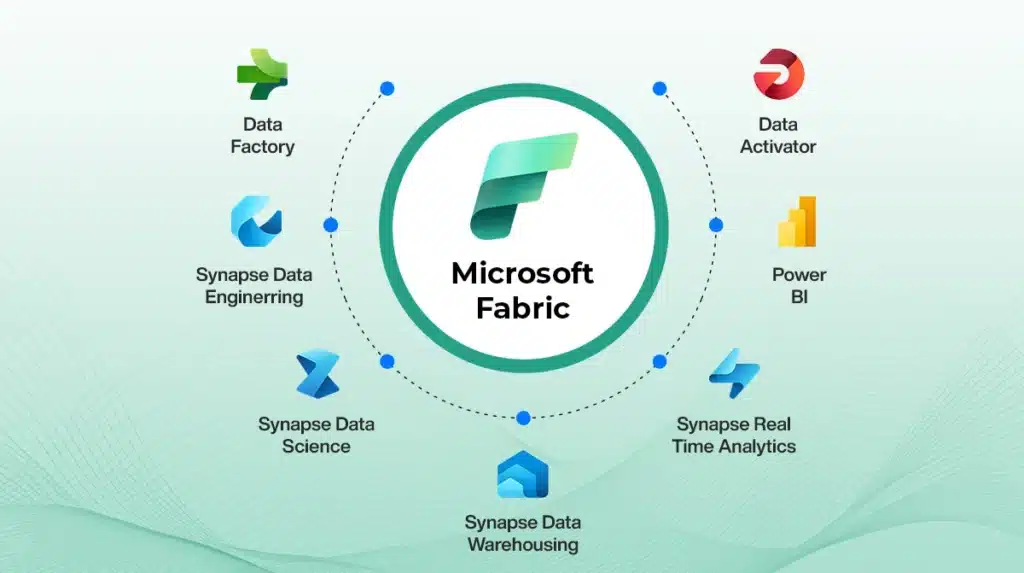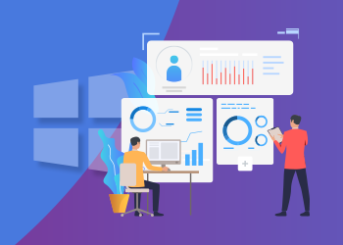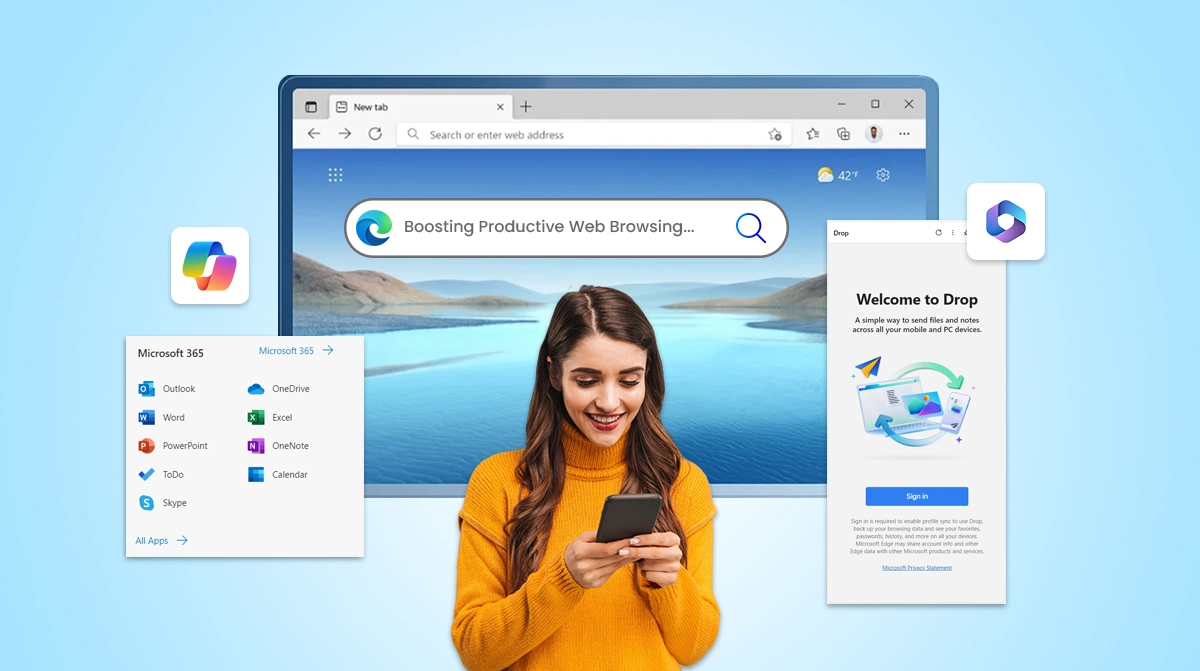In today’s data-driven economy, information flows from countless sources—CRM tools, IoT devices, marketing platforms, ERPs, etc. Yet most companies still struggle with fragmented data environments. Silos slow down decision-making, analytics remain reactive rather than proactive, and critical business insights are lost in complexity.
Enter Microsoft Fabric—a groundbreaking, unified data platform that brings together the power of Microsoft’s data ecosystem under one roof. Think of it as the Swiss Army knife of enterprise analytics. But it’s more than just a toolset; with microsoft enterprise development services, it represents a fundamental shift in how your business can approach, manage, and leverage data.
What Is Microsoft Fabric?
Microsoft Fabric is an end-to-end, SaaS-based data analytics platform that integrates various Microsoft technologies—Power BI, Azure Synapse Analytics, Data Factory, Data Lake, and AI—into a unified experience. Fabric is designed for technical and non-technical users, offering scalability, security, and user-friendliness without compromising performance.
Core Components of Microsoft Fabric
- Data Factory: For data integration and orchestration.
- Synapse Data Engineering: You can author Spark jobs and manage data pipelines.
- Synapse Data Warehousing: Provides lakehouse architecture for storage and computation.
- Power BI: Embedded for real-time data visualization and sharing.
- Data Science: Build and train machine learning models.
- Real-Time Analytics: Analyze streaming data from sources like IoT or logs.
- OneLake: A unified, software-defined data lake.
Why Microsoft Fabric Matters
In a world where data is everything, most organizations still juggle a messy tangle of disconnected tools just to make sense of it. Traditional analytics platforms require teams to patch together data lakes, ETL pipelines, reporting tools, and AI models, draining resources and delaying decisions. Microsoft Fabric changes the game by bringing it all together.
By integrating data engineering, data science, real-time analytics, and business intelligence into a single experience, Microsoft Fabric helps organizations streamline operations and unlock real value from their data.
Here’s why Microsoft Fabric is a game-changer:
- Unified interface: One platform for everything from ingestion to visualization
- Data consistency: A single source of truth across your organization
- Lower costs: Reduced licensing, infrastructure, and maintenance overhead
- Accelerated insights: Weeks-long processes now take just minutes
- Faster decisions: Empower leaders to respond swiftly and strategically
- Better collaboration: Teams work from the same tools and datasets
For business leaders, this translates to more thoughtful planning, faster strategy execution, and the agility to thrive in dynamic markets. Microsoft Fabric doesn’t just simplify analytics—it empowers transformation.
Real-World Use Cases of Microsoft Fabric
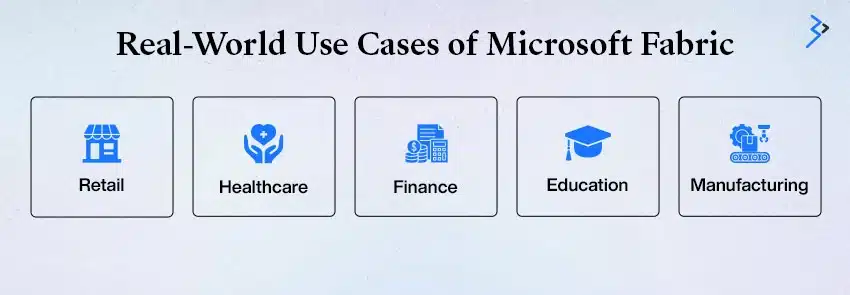
Microsoft Fabric is more than just a unified analytics platform—it’s a transformative tool adopted across industries to drive innovation, reduce inefficiencies, and turn data into actionable insights. Let’s explore how businesses leverage Microsoft Fabric to solve their toughest challenges and accelerate decision-making.
1. Retail: Optimizing Inventory & Personalized Marketing
Retailers face constant pressure to balance stock levels and deliver personalized customer experiences. Microsoft Fabric allows large retail chains to unify data from multiple touchpoints—including point-of-sale systems, eCommerce platforms, and supply chain sensors—into a single, intelligent ecosystem.
With Fabric, retailers can:
- Forecast inventory using AI models trained on real-time and historical data
- Trigger personalized promotions through CRM and customer behavior integrations
- Reduce stockouts by up to 30% with live dashboards and predictive alerts
This translates to happier customers, leaner inventories, and higher profit margins.
2. Healthcare: Enhancing Patient Care
In healthcare, data is everywhere—but often trapped in disconnected systems. Hospitals that adopt Microsoft Fabric gain a unified view of patient data across electronic health records (EHRs), wearable devices, and lab results.
Benefits include:
- Unified dashboards that offer real-time patient summaries for clinicians
- Predictive models that assess readmission risks for proactive interventions
- Automated compliance and insurance reporting
By breaking down silos, providers can deliver smarter, more personalized care while improving operational efficiency.
3. Manufacturing: Predictive Maintenance & Supply Chain Insights
Manufacturers leverage Microsoft Fabric to connect machine-level IoT data with enterprise systems like SAP. This allows for powerful insights that optimize operations and minimize downtime.
Fabric enables manufacturers to:
- Predict equipment failures days in advance using sensor-based analytics
- Monitor key performance indicators like OEE in real time
- Optimize vendor performance with data-backed procurement strategies
These capabilities lead to better asset utilization and lower operational risk.

4. Finance: Real-Time Fraud Detection
In the financial sector, speed and accuracy are critical. A global bank using Microsoft Fabric merged real-time transactional data with behavioral logs to detect anomalies and prevent fraud instantly.
Key improvements include:
- Real-time fraud flagging through advanced anomaly detection models
- Rapid historical analysis with consolidated transaction logs
- Faster customer dispute resolution through unified customer views
Microsoft Fabric helps financial institutions protect assets, ensure compliance, and deliver superior customer experiences.
5. Education: Enhancing Student Outcomes
Universities often operate with fragmented systems for learning, attendance, and assessment. Educational institutions can combine this data with Microsoft Fabric to foster student success.
Education use cases include:
- Early-warning systems that notify counselors of at-risk students
- Dashboards for deans to monitor departmental performance and trends
- Instant generation of funding and accreditation reports
This empowers educators to act proactively and helps institutions drive measurable improvements in student outcomes.
Microsoft Fabric Implementation Strategies
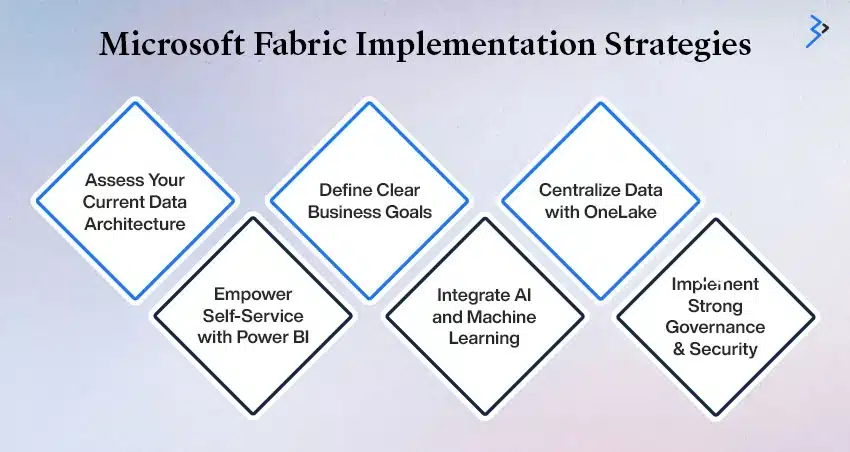
Adopting Microsoft Fabric isn’t just a tech upgrade—it’s a strategic transformation. With the right approach, you can streamline data workflows, democratize analytics, and accelerate value creation across your organization. Partnering with a net app development company can help you build custom connectors, extend Fabric with .NET-based services, and align the rollout with existing enterprise applications. Here’s how to roll it out effectively:
1. Assess Your Current Data Architecture
Before diving in, conduct a full audit of your current ecosystem. Understand what you’re working with to avoid costly surprises.
- Catalog your data sources
- Evaluate your integration pipelines
- Analyze existing analytics workflows
- Identify compliance and security constraints
2. Define Clear Business Goals
Your Fabric implementation should support your strategic vision. What does success look like?
- Need faster, real-time reporting?
- Want to reduce cloud and tool costs?
- Interested in AI-powered predictions?
- Seeking better collaboration between departments?
Align these goals with Fabric’s capabilities to stay focused.
3. Centralize Data with OneLake
OneLake serves as the unified data repository—your organization’s “single source of truth.”
- Supports open formats like Delta and Parquet
- Simplifies data ingestion and sharing
- Enables seamless querying across sources
4. Empower Self-Service with Power BI
Let your business teams explore data without IT bottlenecks.
- Build intuitive dashboards using drag-and-drop tools
- Embed insights directly into apps
- Schedule reports and monitor KPIs automatically
5. Integrate AI and Machine Learning
Unlock predictive insights and automation by integrating AI machine learning into your workflows.
- Build ML models using notebooks
- Train them with Fabric’s compute power
- Deploy and monitor results at enterprise scale
6. Implement Strong Governance and Security
Trust is everything—secure your data with built-in tools.
- Use Microsoft Purview for data governance
- Control access via Azure Active Directory
- Track data lineage and meet standards like HIPAA & GDPR
With the proper foundation and strategy, Microsoft Fabric can become a catalyst for smarter, faster, and more connected business operations.
Industry-Specific Benefits of Microsoft Fabric
Microsoft Fabric isn’t just a one-size-fits-all solution—it’s a highly adaptable data platform that brings value to diverse industries by simplifying data operations, accelerating insights, and fueling smarter decisions. Let’s explore how various sectors tap into Fabric’s unified architecture for transformative results.
Tech & SaaS: Speed, Scale, and Simplicity
Tech-driven companies need fast development cycles and scalable infrastructure to stay competitive. Microsoft Fabric empowers them with:
- Reusable lakehouses for building modular, agile data products
- End-to-end DevOps integration for shortening analytics development and deployment lifecycles
- Multi-tenant analytics made simple without complex partitioning or infrastructure overhead
- Unified governance to support fast-moving teams with secure access
By streamlining data operations, Tech & SaaS teams can innovate faster and deliver data-as-a-product efficiently.
Read More – Harnessing Data Insights: Power BI’s Impact on the Energy Industry
Retail: Smarter Operations and Personalized Experiences
Retailers thrive on real-time insights. Fabric provides a 360° view of operations, from supply chain to customer interactions:
- Live inventory visibility helps avoid overstock or out-of-stock issues
- Geo-targeted campaigns based on customer behavior and location
- Seamless supply chain monitoring, from warehouse movement to doorstep delivery
- Integrated sales forecasting and promotions management through AI
Retailers gain the agility to respond instantly to market trends and customer needs.
Healthcare: Better Patient Outcomes and Compliance
In healthcare, precision and privacy are everything. Fabric unifies fragmented systems to improve care and compliance:
- Faster HIPAA-aligned reporting and data access auditing
- Integrated dashboards for clinical, financial, and operational data in one view
- AI-driven patient insights, enabling proactive care pathways and readmission prevention
- Scalable research data management for clinical studies
This results in better decisions at the bedside and in the boardroom.
Manufacturing: Efficiency and Predictability
Manufacturers rely on real-time data to keep machines running and production optimized. Microsoft Fabric offers:
- IoT integration for live machine monitoring and predictive maintenance
- Global production analytics to compare factory performance across geographies
- Vendor tracking dashboards to evaluate supplier reliability and optimize logistics
- Quality control insights embedded directly into production workflows
Manufacturers can reduce downtime, improve output quality, and make operations more agile with Fabric.
Finance: Risk Reduction and Insightful Reporting
The financial sector depends on data accuracy and regulatory readiness. Fabric simplifies it all with:
- Automated compliance for SOX, Basel III, and other frameworks
- Accelerated KYC processes through unified customer data
- Real-time fraud detection and alerting with embedded AI models
- Portfolio performance dashboards for investors and analysts alike
Financial institutions can act faster and with more confidence.
Education: Student Success Through Data
Educational institutions juggle funding, performance, and student well-being. Fabric helps unify their goals:
- Student engagement tracking across LMS, attendance, and assessments
- Budget forecasting and streamlined grant reporting
- Simple accreditation compliance with automated report generation
- Data-driven interventions to support at-risk students
By turning fragmented education data into actionable insight, schools and universities foster better outcomes for all.
How Microsoft Fabric Compares to Alternatives
| Feature | Microsoft Fabric | Snowflake | Databricks | Google BigQuery |
| Unified Platform | Yes | No (Requires stack) | No (Requires stack) | No |
| Native AI Integration | Yes | Partial | Yes | Partial |
| Power BI Integration | Yes | No | No | No |
| Built-In Governance | Yes | No | No | Partial |
| Pricing Model | SaaS-based | Usage-based | Usage-based | Usage-based |
Benefits for Stakeholders
For CIOs
- Consolidate platforms and reduce licensing.
- Improve data strategy alignment with business outcomes.
For Data Engineers
- No more jumping between Spark, SQL, and ETL tools.
- Faster pipeline creation and deployment.
For Analysts
- Self-service reporting without IT delays.
- Cross-departmental dashboards in hours, not weeks.
For Executives
- One version of the truth.
- Strategic decisions backed by real-time data.
Challenges and Considerations When Adopting Microsoft Fabric
While Microsoft Fabric offers a powerful and unified data experience, successful adoption requires navigating several challenges.
- Migration Complexity: Transitioning from legacy systems isn’t plug-and-play. Many organizations may need to develop custom scripts and adopt a phased migration approach to reduce risk and minimize disruption.
- Training & Change Management: Introducing a unified platform means teams must unlearn old tools and embrace new workflows. This shift calls for a solid change management strategy, user training, and internal champions to drive adoption.
- Cost Forecasting: Although Fabric’s SaaS billing model is straightforward, uncontrolled usage can lead to unexpected costs. Organizations must monitor data usage, workloads, and scaling to align expenses with ROI.
Ultimately, organizations should carefully plan their rollout, invest in user enablement, and establish strong governance to realize Microsoft Fabric’s full potential.
Future Roadmap & Microsoft’s Vision
Microsoft invests heavily in AI integration, enhanced connectors, and vertical-specific templates (e.g., healthcare accelerators). In upcoming releases, expect tighter Copilot integration, low-code options, and stronger multi-cloud capabilities.
Transform Your Data Journey with Microsoft Fabric
Microsoft Fabric isn’t just a new tool—it’s a new way to think about data. With its unified platform, robust AI capabilities, With seamless Power BI integration, it has the power to transform your data into actionable insights. Our Power BI consulting services ensure you leverage these capabilities effectively for smarter decision-making.
- Break down silos,
- Reduce time to insight,
- Empower every user to become a data hero.
Microsoft Fabric can transform your company if it handles large datasets, juggles multiple BI tools, or struggles to align data strategy with business goals.
Ready to transform your data journey with Microsoft Fabric?
Explore how Fabric can unify your analytics stack, cut down silos, and unlock powerful insights. Talk to our experts today and take the first step toward data-driven excellence.
FAQs
Microsoft Fabric is an integrated data platform that unifies analytics, AI capabilities, and BI tools in one space. It helps businesses break down data silos, enhance decision-making, and gain actionable insights faster.
By consolidating data management and analytics into a single platform, Microsoft Fabric reduces complexity, enhances collaboration, and provides real-time insights. This accelerates the decision-making process and enables more effective data-driven strategies.
Microsoft Fabric streamlines data integration, enables faster insights, reduces the cost of ownership, and promotes scalability. Its AI and machine learning features enhance predictive analytics and business intelligence across departments.
Yes, Microsoft Fabric integrates seamlessly with existing tools, including Power BI, Azure, and various data sources. It allows businesses to leverage their current systems, improving analytics and operational efficiency.
Microsoft Fabric greatly benefits retail, healthcare, finance, manufacturing, and tech industries. Its ability to centralize data, improve forecasting, and enhance operational visibility makes it versatile across various sectors.
Related Articles
-
Microsoft SharePoint 2019: What’s new?
Ever since Microsoft launched its web-based collaborative platform SharePoint in 2001, there has been constant innovation in the process. The latest unveiling is that of the SharePoint Server 2019, which
-
What role does Data Analytics play in HR Portals in Employee Performance?
Industries like Healthcare, Media & Entertainment, Logistics, Real estate, Finance, Education, Automobile, Mobile & Wireless, Cloud Services, Retail, Advertising, and so on; needs HR staff to handle the company culture,
-
Microsoft Edge: Boosting Productive Web Browsing Experience
Introduction In today’s fast-paced digital landscape, productivity is paramount. As we spend increasingly more time online, the need for a web browser that not only keeps up with our demands

